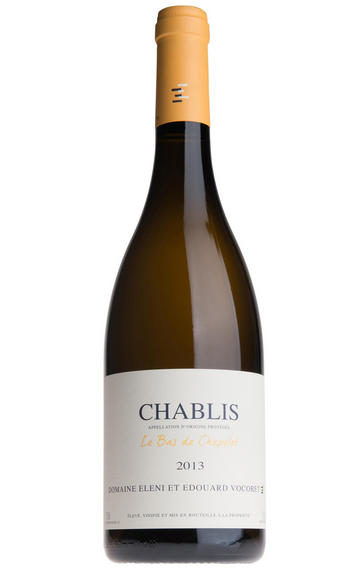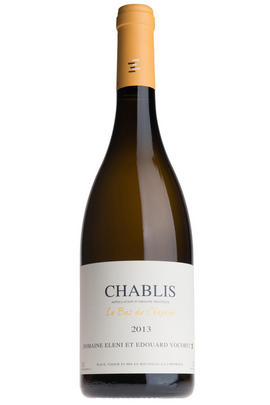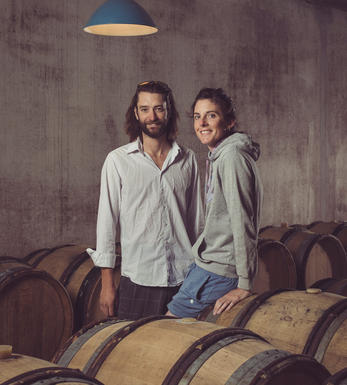
2013 Chablis, Le Bas de Chapelot, Domaine Eleni & Edouard Vocoret, Burgundy

About this WINE

Domaine Eleni et Edouard Vocoret
Edouard's family owns Domaine Vocoret & Fils, a well known and large Chablis domaine, with over 50 hectares planted including six Chablis premiers crus and renowned for its solid, tradionally-styled wines. Edouard and Eleni partnered while in New Zealand but returned to Chablis to run a small plot of 3.3 hectares in the family vineyard.
They are currently producing two wines: Chablis "Bas de Chapelot" and Chablis 1er Cru "Butteaux." Bas de Chapelot comes from 3ha just beneath Montée de Tonnerre while the Butteaux parcel is 0.3ha. Vincent Dauvissat is a mentor and a source of inspiration for the Vocorets.

Chablis
Chablis lies further north than the rest of Burgundy, located about halfway between Beaune and Paris; it’s actually not all that far from Champagne. The wines here – exclusively whites from Chardonnay – differ in style from other white Burgundies: they tend towards steeliness and flintiness.
The Chablis region is an island of vines lying amid the forests and pastures of the Yonne département. In the heart of Chablis, the soils are marl (clay-limestone) of a particular kind – Kimmeridgian – containing traces of marine fossils. For many, the classic aroma and flavour profile of Chablis is built around seashell and an iodine, marine character imparted by the soil.
As elsewhere in Burgundy, there’s a hierarchy in Chablis. Grand Cru represents the top tier, although it accounts for just one per cent of overall Chablis production. The Grand Cru vineyards rise above the eponymous town in an impressive sweep, sloping south. These are sunny sites, ranging in elevation from 100 to 250 metres above sea level. The wines are deep and powerful, benefitting hugely from bottle age after release. The best examples can age for up to 20 years. Over time, their colour evolves from greenish gold to a light yellow, and they develop real aromatic complexity.
Unlike the other tiers, it’s not uncommon for Grand Cru Chablis to see new oak. As a result, its flavour profile is perhaps more comparable to the Côte d’Or than the rest of Chablis. For something more classically “Chablis”, there’s the Premiers Crus. Style and quality can vary, depending on the climat and the producer. Whether floral or more mineral, the best examples are seriously impressive and represent the hallmark style of the region – they can also offer real value for money. These are structured wines with the capacity to age for 10 to 15 years.
The next tier – accounting for most of the region’s output – is labelled simply as “Chablis”. These are steely, clean and lean whites with aromas of green apples and lemon, intended for early drinking. As ever in Burgundy, there are exceptions: well-made examples by top growers from vineyards abutting the Premiers Crus can be age-worthy.
Finally, there’s Petit Chablis: everyday wines, generally from vineyards planted on higher slopes. Petit Chablis accounts for around one-fifth of all Chablis produced. These wines typically come from Portlandian limestone, known to produce a fruitier, simpler wine than Chablis.

Chardonnay
Chardonnay is often seen as the king of white wine grapes and one of the most widely planted in the world It is suited to a wide variety of soils, though it excels in soils with a high limestone content as found in Champagne, Chablis, and the Côte D`Or.
Burgundy is Chardonnay's spiritual home and the best White Burgundies are dry, rich, honeyed wines with marvellous poise, elegance and balance. They are unquestionably the finest dry white wines in the world. Chardonnay plays a crucial role in the Champagne blend, providing structure and finesse, and is the sole grape in Blanc de Blancs.
It is quantitatively important in California and Australia, is widely planted in Chile and South Africa, and is the second most widely planted grape in New Zealand. In warm climates Chardonnay has a tendency to develop very high sugar levels during the final stages of ripening and this can occur at the expense of acidity. Late picking is a common problem and can result in blowsy and flabby wines that lack structure and definition.
Recently in the New World, we have seen a move towards more elegant, better- balanced and less oak-driven Chardonnays, and this is to be welcomed.


Buying options
Add to wishlist
Description
Picked on 29th September, well before the bad weather arrived. The wine shows the fleshy nature of the best 2013s, along with attractive floral notes, refreshing acidity tucked in behind the fruit and a fine, balanced finish. Drink 2015-2018
Jasper Morris MW, Burgundy Wine Director
Edouard Vocoret is the scion of one of Chablis’ well known families. He met Eleni (née Theodoropoulos ) when they were both working in New Zealand, since when he has apprenticed with the excellent Daniel Barraud (Pouilly Fuissé) while Eleni has been working with Vincent Dauvissat who has given them a great deal of help in setting up their own small domaine in Chablis. We have nicknamed this promising pair the Vocoropouloi.
There are just two wines from the debut vintage, 2013, which has been hand harvested and matured in wood, using older barrels. They have nearly five hectares of Chablis, in three plots, the largest being Le Bas de Chapelot, just below Montée de Tonnerre. This is the only one currently being bottled. There is also a small holding of 1er cru Les Butteaux.
wine at a glance
Delivery and quality guarantee